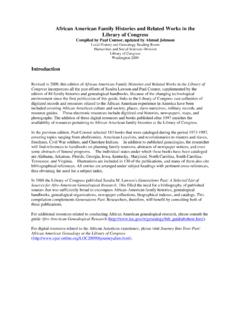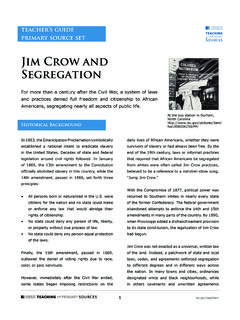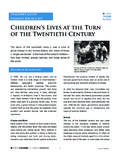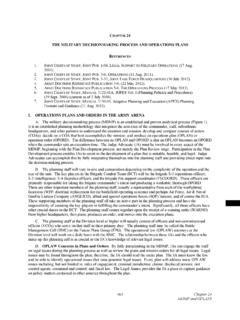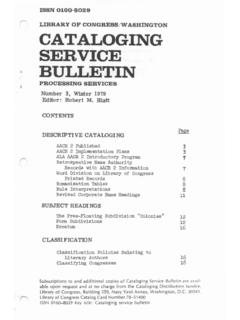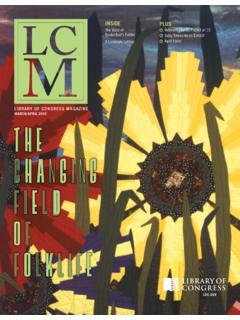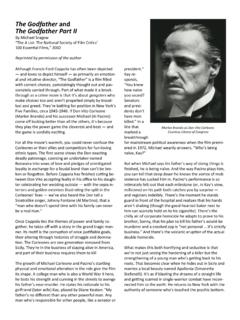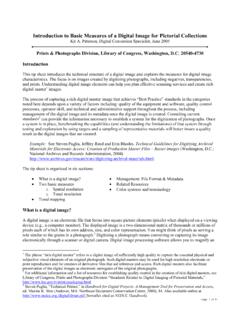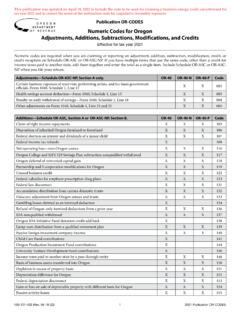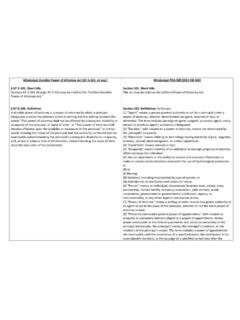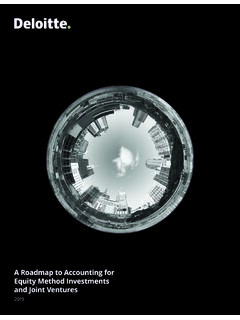Transcription of NOVEMBERDECEMBER 2021 GIFTS THAT KEEP GIVING
1 LIBRARY OF CONGRESS MAGAZINENOVEMBER/DECEMBER 2021 GIFTS T H AT KEEP GIVINGHow donations from civic-minded citizens help build the Library s collectionsInsideRumors of WarThe Birth of JoeHistory, Written in ClayLIBRARY OF CONGRESS MAGAZINEFEATURESA Survivor s TaleA photographer survivedthe Holocaust and gavehis images to the That Keep GivingDonations from civic-minded citizens helpbuild Library Smith s StoryAn 18th-century volumemarks the earliest slavenarrative in the Noemi R zs donated to the Library a large collection of luggage labels gathered by her father at hotels in the United States in the mid-20th century a visual record of travel and hotel advertising. Shawn MillerNOVEMBER/DECEMBER 2021 1 DEPARTMENTS2 Trending 3 Extremes4 Online Offerings6 Page from the Past7 Favorite Place8 Curator s Picks22 Te chnolog y24 My Job25 News Briefs26 Shop the Library27 Support the Library28 Last Word362228 On the cover: Gertrude Clarke Whittall donated to the Library five stringed instruments produced by master maker Antonio Stradivari, including this Castelbarco violin made in Cremona in 1699.
2 Michael Zirkle / Prints and Photographs DivisionCONNECT OF CONGRESS MAGAZINENOVEMBER / DECEMBER 2021 VOL. 10 NO. 6 Mission of the Library of CongressThe Library s mission is to engage, inspire and inform Congress and the American people with a universal and enduring source of knowledge and creativity. Library of Congress Magazine is issued bimonthly by the Office of Communications of the Library of Congress and distributed free of charge to publicly supported libraries and research institutions, donors, academic libraries, learned societies and allied organizations in the United States. Research institutions and educational organizations in other countries may arrange to receive Library of Congress Magazine on an exchange basis by applying in writing to the Library s Director for Acquisitions and Bibliographic Access, 101 Independence Ave.
3 , Washington DC 20540-4100. LCM is also available on the web at All other correspondence should be addressed to the Office of Communications, Library of Congress, 101 Independence Ave. , Washington DC 20540-1610. ISSN 2169-0855 (print) ISSN 2169-0863 (online)Carla Hayden Librarian of CongressApril Slayton Executive EditorMark Hartsell EditorAshley Jones DesignerShawn Miller Photo EditorContributors Mark Dimunation Sara Duke Leah Knobel Kaffie Milikin Susan Peckham David Rubenstein Neely Tucker Margaret McAleerTRENDINGTHE GREAT FIREOn Christmas Eve in 1851, a blaze destroyed most of the Library s unparalleled collections of the Library of Congress were forged in 1814, an invading British army burned the Capitol, destroying the 3,000 volumes of the Library, then housed in the Capitol building.
4 The destruction prompted Thomas Jefferson to sell his personal library to Congress 6,487 volumes that formed the new basis of the Library s devastating fire, 170 years ago this Christmas Eve, wiped out most of that. For the second time the Library of Congress has been destroyed by fire, The Daily Union reported on Dec. 30, 1851. The precious accumulations of more than thirty years have been reduced, in one short, melancholy hour, to a mass of black cinders and worthless fragments. The fire was discovered in the early morning of Dec. 24 by Capitol police Capt. John Jones, making his rounds. He smelled smoke, opened the door to the Library and discovered the flames, spreading and others tried in vain to extinguish the fire, then decided to call in help.
5 But the fire companies were slow to arrive and, when they did, were hampered by equipment frozen by the extreme fire inflicted enormous damage. Two-thirds of the Library s 55,000 volumes were destroyed, including two-thirds of Jefferson s books. It also destroyed irreplaceable artworks, among them portraits of the first three presidents by Gilbert Stuart and busts of Jefferson and culprit, it turned out, was a faulty flue: Builders had inserted the ends of wooden support beams into the structure of a chimney, where they caught 1998, the Library embarked on a project to re-create Jefferson s original library by seeking out identical editions of titles lost in the blaze. The effort has been a success: Today, only about 240 volumes remain to be reconstituted collection is on display in the Library building that today bears Jefferson s name a reminder of the fragility of our cultural heritage and the importance of preserving it for future generations.
6 The Library of Congress as it appeared about 1870, when it was located inside the Capitol. Prints and Photographs Division2 LIBRARY OF CONGRESS MAGAZINEEXTREMESWRITTEN IN CLAYT ablets with an ancient writing system are among the oldest items in the the oldest pieces in the Library s collection of 171 million items are a group of clay tablets from ancient Mesopotamia that date to the dawn of tablets contain an ancient writing system known as cuneiform developed by the Sumerians, who thrived during the third millennium Sumerians influenced culture and development beyond their original home in Mesopotamia (present-day southern Iraq) the site of the world s earliest civilization. The materials used to create cuneiform clay and reeds were both readily available in this region at the time.
7 Initially, cuneiform signs were pictograms but later became syllabic, or based on symbols, causing some ambiguity in their interpretation. The Library acquired this collection of cuneiform materials in 1929 from art dealer Kirkor Minassian. The items were part of Minassian s collection of Islamic bookbindings, manuscripts, textiles and ceramic and metal objects that demonstrate the development of writing and book art in the Middle oldest tablets in the collection date from the reign of Gudea of Lagash (2144 2124 ). The tablets contents are diverse. Several contain inscriptions pertaining to the receipt of and payment for goods and services, while others appear to have served as school exercise tablets, used by scribes learning the cuneiform writing system.
8 These latter tablets were originally unfired, as they were meant to be erased and reused; the account records, on the other hand, were fired and stored for future reference. Leah Knobel is a public affairs specialist in the Office of INFORMATIONC uneiform tablets at the Library This tablet, a receipt for livestock from what today is Iraq, dates from about 2000 African and Middle Eastern DivisionNOVEMBER/DECEMBER 2021 3 ONLINE OFFERINGSRUMORS OF WARD uring World War II, a government project tried to track what citizens said about the the summer of 1942, shortly after the United States entered World War II, the newly minted Office of War Information (OWI) began to try to find out what people were saying about the conflict, from jokes in Georgia to conspiracy theories in campaign, which enlisted secret civilian reporters from all over the country, was unofficially called rumor control.
9 Its stated intention was to correct misinformation and morale-killing gossip that might aid enemy efforts to demoralize the turned out people were speculating about the war quite a bit. Our democratic system will not survive the war the President desires a socialist state, read one reported rumor from Seven widely scattered States. Another: Japanese treat Negroes as equals this is a white man s war. (Seven States, Southeast and Northeast.) Others reported German submarines that had been sunk off the Florida coast, that the losses at Pearl Harbor had been much worse than had been reported, or that parachutes had been spotted in the central part of Florida, and spies were now among us. And so project was taking place at an early stage of mass communications, with radio and newspapers and magazines being dominant and television just coming on the scene.
10 Local rumors couldn t go viral because there was no technology to make it happen, unlike today s social media. So the OWI recruited hundreds of everyday Americans bank workers, taxi drivers, students, office clerks to confidentially report to a government handler what their fellow citizens were saying in private conversations, no names short, to spy on one another in the name of natural comparison would be to George Orwell s classic novel, 1984, the dark tale of a government that monitors everything its citizens say and think and encourages its civilians to do the same but that landmark book wouldn t be written for another seven years. The OWI seemed aware of the perils of a democratic nation urging citizens to report on one another and cautioned that care must be taken to prevent the community from feeling that a Gestapo is being organized.
